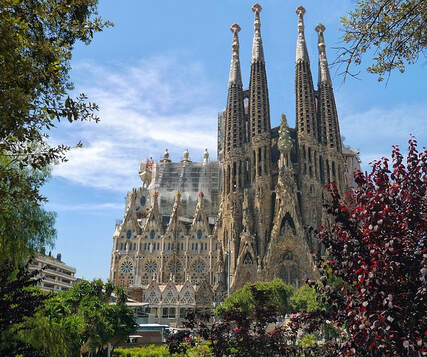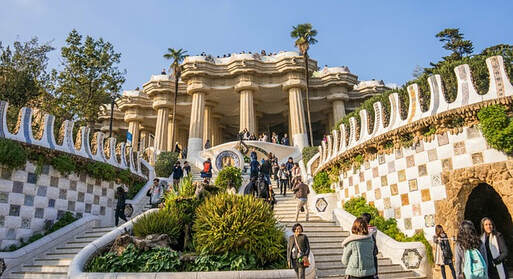The works of Gaudi

Antoni Gaudi’s masterpiece is the Sagrada Familia (pictured left), a giant church built for a Catholic foundation and dedicated to the Christian Holy Family. Most of the existing structure was built over 40 years within Gaudi’s lifetime, but the church remains incomplete. The church features fantastical sculpture and decorations depicting various scenes from the bible. The structure is dominated by the four towers on the Nativity façade, which can be viewed from far away.
Construction has continued in the last few decades, but the Sagrada Familia remains far from completion. Gaudi was conscious of the fact that the church would not be completed in his lifetime, so he has left numerous drawings and models for future reference. There are expected to be 12 towers upon completion, with the tallest in the centre and dedicated to Jesus Christ. When complete, the church is expected to serve as an illustration of the Bible, with a narrative starting from Adam and Eve to the evangelism of the Apostles.
Within the town area itself, the Passeig Gracia is virtually a one-stop museum dedicated to the works of Barcelona’s most famous architects of the era. There is the Casa Amatller by Josep Puig I Cadalfach, the Casa Morera by Domenech I Montaner and two works by Gaudi — Casa Battlo and Casa Mila. These were homes and apartment blocks financed by wealthy businessmen of the era who had made their fortunes in railroads, textiles and banking.
Construction has continued in the last few decades, but the Sagrada Familia remains far from completion. Gaudi was conscious of the fact that the church would not be completed in his lifetime, so he has left numerous drawings and models for future reference. There are expected to be 12 towers upon completion, with the tallest in the centre and dedicated to Jesus Christ. When complete, the church is expected to serve as an illustration of the Bible, with a narrative starting from Adam and Eve to the evangelism of the Apostles.
Within the town area itself, the Passeig Gracia is virtually a one-stop museum dedicated to the works of Barcelona’s most famous architects of the era. There is the Casa Amatller by Josep Puig I Cadalfach, the Casa Morera by Domenech I Montaner and two works by Gaudi — Casa Battlo and Casa Mila. These were homes and apartment blocks financed by wealthy businessmen of the era who had made their fortunes in railroads, textiles and banking.

The 3 houses of Passeig Gracia
The Casa Amatller is topped by a stepped triangle on the front façade, and on the lower levels there are sculptures of St. George and the Dragon, St. George being the patron saint of Catalunya. The inside of the building features colourful decorative tiles and a stained glass skylight, which opens to the foyer. The house was built for a chocolate manufacturer and you can still but Amatller chocolates here.
Casa Lleo Morera, or the house of Lion and Mulberry, is located at the corner of Passeig Gracia. This house also features decorative sculpture, but here the focus of attention is on the modern luxuries which were just then becoming available to the middle class — gramophone, electric bulb, telephone and camera, all held by nymphs. There are also carvings to relate the building to the family name — Lleo or Lion, and Morera or mulberry, the food of silkworms which were the source of the family wealth.
The last great house on the block, Casa Battlo, is best described as a house with no straight lines. The drooping façade is made of a combination of lime mortar, fragments of coloured glass and ceramic pieces. It is blue in colour, dark at the top and lightening as you move downwards. The roof is decorated with oddly shaped chimney pipes and dominated by a tower. Similar to many of Gaudi’s buildings, this one also has a narrative story, about St. George and the Dragon. The tower is interpreted as the lance piercing the dragon, which is represented by the wavy roof. The stairwell is supposed to be the dragon’s backbone, while the balconies and columns on the outside are the bones and skulls of its unfortunate victims.
2 Gaudi Masterpieces — Casa Mila and Parc Guell
Further apart from the three, is the groundbreaking Casa Mila. Built as an apartment complex, it has been lampooned as a parking complex for airships due to its large shapeless windows in a multilevel honeycomb-like structure. The building is now a UNESCO world Heritage Site and the ground level and roof are open to the public for exhibition. The roof has curiously shaped chimneys and air vents which look like old-fashioned candy sticks, and arches to support the attic. The building bears the nickname of La Pedrera, or the Quarry, due to its resemblance to a wind-swept rock face.
Yet another Gaudi masterpiece is the Parc Guell (pictured right) which overlooks Barcelona. A park filled with fantastical and colourful forms, this place has been described as what happens when a dream comes to life. The centre of attraction is an 86 columned chamber which was supposed to have been a market. The park itself was meant to have been a gated residential development, but due to the poor response, it remained an open park.
There are lizards and other creatures decorated with multi-coloured tiles lining the stairways and fountains around the park. Snaking along the edge of the main plaza, there is a long bench decorated with broken glass pieces and tiles. The entrance gates are dominated by houses which can best be described as something out of Hansel and Gretel, looking very much like it was made of candies and chocolates drooping from the roof.
Take a tour of the streets and parks to explore these landmarks, and you will be rewarded with numerous photo opportunities, and these may vary even as the day passes.
The Casa Amatller is topped by a stepped triangle on the front façade, and on the lower levels there are sculptures of St. George and the Dragon, St. George being the patron saint of Catalunya. The inside of the building features colourful decorative tiles and a stained glass skylight, which opens to the foyer. The house was built for a chocolate manufacturer and you can still but Amatller chocolates here.
Casa Lleo Morera, or the house of Lion and Mulberry, is located at the corner of Passeig Gracia. This house also features decorative sculpture, but here the focus of attention is on the modern luxuries which were just then becoming available to the middle class — gramophone, electric bulb, telephone and camera, all held by nymphs. There are also carvings to relate the building to the family name — Lleo or Lion, and Morera or mulberry, the food of silkworms which were the source of the family wealth.
The last great house on the block, Casa Battlo, is best described as a house with no straight lines. The drooping façade is made of a combination of lime mortar, fragments of coloured glass and ceramic pieces. It is blue in colour, dark at the top and lightening as you move downwards. The roof is decorated with oddly shaped chimney pipes and dominated by a tower. Similar to many of Gaudi’s buildings, this one also has a narrative story, about St. George and the Dragon. The tower is interpreted as the lance piercing the dragon, which is represented by the wavy roof. The stairwell is supposed to be the dragon’s backbone, while the balconies and columns on the outside are the bones and skulls of its unfortunate victims.
2 Gaudi Masterpieces — Casa Mila and Parc Guell
Further apart from the three, is the groundbreaking Casa Mila. Built as an apartment complex, it has been lampooned as a parking complex for airships due to its large shapeless windows in a multilevel honeycomb-like structure. The building is now a UNESCO world Heritage Site and the ground level and roof are open to the public for exhibition. The roof has curiously shaped chimneys and air vents which look like old-fashioned candy sticks, and arches to support the attic. The building bears the nickname of La Pedrera, or the Quarry, due to its resemblance to a wind-swept rock face.
Yet another Gaudi masterpiece is the Parc Guell (pictured right) which overlooks Barcelona. A park filled with fantastical and colourful forms, this place has been described as what happens when a dream comes to life. The centre of attraction is an 86 columned chamber which was supposed to have been a market. The park itself was meant to have been a gated residential development, but due to the poor response, it remained an open park.
There are lizards and other creatures decorated with multi-coloured tiles lining the stairways and fountains around the park. Snaking along the edge of the main plaza, there is a long bench decorated with broken glass pieces and tiles. The entrance gates are dominated by houses which can best be described as something out of Hansel and Gretel, looking very much like it was made of candies and chocolates drooping from the roof.
Take a tour of the streets and parks to explore these landmarks, and you will be rewarded with numerous photo opportunities, and these may vary even as the day passes.